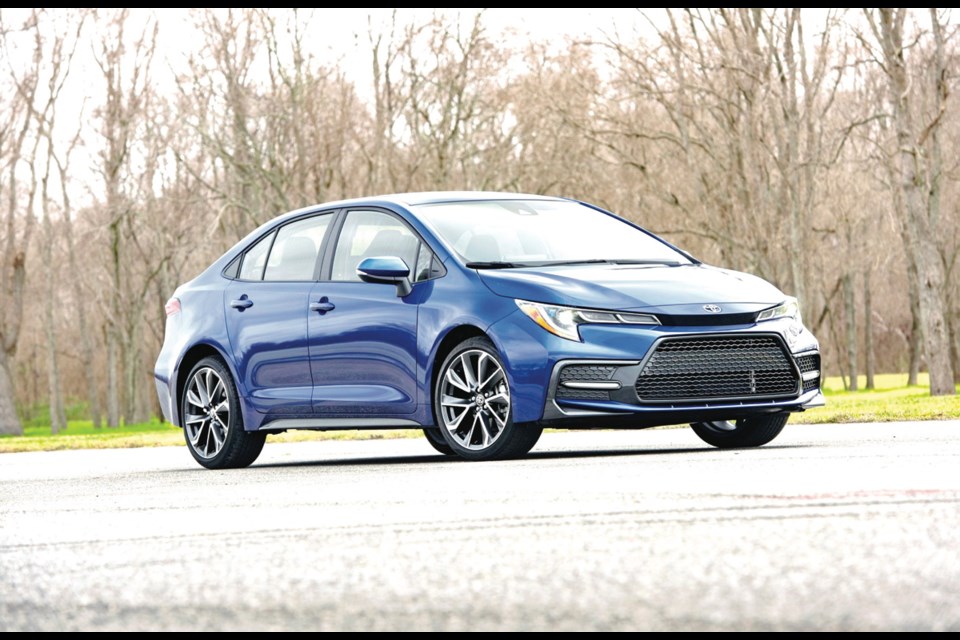More than 46 million Toyota Corollas have been sold since the nameplate's beginnings in the 1960s, making it the most popular car in automotive history.
That means there’s constant pressure on Toyota to keep the ball moving forward in terms of comfort, reliability and resale value.
The new 12th-generation Corolla sedan, which joins the new-for-2019 Corolla Hatchback, might not be the sharpest-looking sled on the block, or the quickest, but it’s special for other reasons.
The Corolla is ideal for people who don’t want to think about how the car works, but believe it will work faithfully and safely well past the powertrain warranty stage and/or the monthly loan or lease commitment.
The 2020 model does however shed much of its previous design frumpiness, including a nose that keeps faith with Toyota’s signature open-mouth grille.
A reduction of about 2.5 centimetres in body height — plus a hood that’s 3.5 cm lower — means a noticeably sleeker silhouette. More curves and creases elsewhere give the Corolla a much-needed character injection.
The adoption of Toyota’s latest TGNA platform hasn’t resulted in any increases to the Corolla's length, width, trunk volume or distance between the front and rear wheels, but the available powertrains now sit slightly closer to the ground, which means a lower centre of gravity.
As well, a new independent rear suspension replaces the previous torsion-beam unit and is claimed to improve both handling and ride comfort.
A redesigned dashboard includes a tablet-style touch screen, larger floor console and armrest, and better-quality trim and seat fabrics.
For 2020, there are three different powerplant choices for Corolla buyers to ponder.
The base unit is a 1.8-litre four-cylinder that basically carries over from 2019 and is rated at 139 horsepower and 126 pound-feet of torque.
Optional is a 2.0-litre four-cylinder — standard issue in the Hatchback — that produces 169 horsepower and 151 pound-feet of torque.
A six-speed manual transmission is standard with the 1.8, while a continuously variable unit (CVT) is optional, but standard with the 2.0.
For the first time, the Corolla can be ordered with a hybrid system similar to what is used in the Toyota Prius. Its 1.8-litre four-cylinder engine (with a CVT) combines with a pair of electric motors to produce 121 horsepower and 105 pound-feet of torque.
As with the Prius, the Corolla Hybrid’s battery pack is located beneath the rear seat (and not within the trunk) so there’s no reduction in storage space with the seatback in place or folded flat.
Best-fuel-economy honours go to the Hybrid with 4.5 l/100 km in combined city-highway driving. That trounces the next-best 2.0-litre four-cylinder model that earns a rating of 6.7 l/100 km (combined). Interestingly, the base 1.8/CVT is a bit thirstier at 7.1 l/100 km, combined.
The base Corolla L starts at $19,800, including destination fees. That gets you fleet-level basics, a seven-inch touchscreen with navigation, and Toyota’s Safety Sense suite of dynamic safety technologies.
The LE trim comes with an eight-inch touch screen, automatic climate control, premium fabric upholstery and up-level interior trim. The SE gets a unique grille and rocker-panel trim, paddle shifters for the CVT, and 18-inch alloy wheels (smaller steelies for the L and LE). You’ll pay a bit more for the SE, but you get the 2.0-litre engine plus sport-type front seats with more side bolstering.
The XLE comes with a power moonroof, adaptive headlights (pivoting left and right as you turn), heated front seats and a premium JBL-brand audio package. The top-rung XSE receives most of the SE’s content (including the more powerful engine with normal and sport driving modes) plus a premium sound system.
Note that the Hybrid costs $3,000 more than the comparably equipped non-hybrid LE.
As a cornerstone vehicle for Toyota, there’s a lot riding on any Corolla redesign, and perhaps more so in the face of a declining small-car market.
After more than 46 million vehicles sold, reliability is perhaps a given for the Corolla. This time around there’s greater emphasis on style and powertrain technology, further enticement for buyers to join the club.
THE SPEC SHEET
Type: Four-door, front-wheel-drive compact sedan
Engines (h.p.): 1.8-litre DOHC I-4, (139); 2.0-litre DOHC I-4 (169); 1.8-litre DOHC I-4 plus electric motor (121 net)
Transmission: Continuously variable (CVT); six-speed manual (opt.)
Market position: The world’s best-selling automobile brand has a history of success spanning five decades. With each successive generation, the Corolla’s reputation as a trusted and trouble-free conveyance has remained intact.
Points: Much improved in the looks department
• New interior treatments and a modern-design touchscreen should help bolster interest
• Available 169-horsepower 2.0-litre engine is quite an improvement over the underwhelming base 1.8
• For more space, the Hatchback is a viable alternative
• An all-wheel-drive option is rumoured to be on the way.
Active safety: Blind-spot warning with cross-traffic backup alert (opt.); active cruise control (std.); emergency braking (std.); pedestrian detection (std.)
L/100 km: (city/hwy) 7.6/5.8 (2.0)
Base price (incl. destination): $19,800
BY COMPARISON
Mazda3
Base price: $19,800
High-style model is available in sedan or hatchback with up to 186 h.p on tap.
Kia Forte
Base price: $18,950
Great style, roomy interior and standard 147-h.p. engine make it a fun ride.
Volkswagen Jetta
Base price: $21,300
The Passat’s junior relation has a punchy turbo I-4. GLI version can really hustle.



